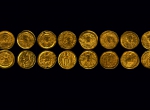Karsibór
Karsibór (fmr. Caseburg), Świnoujście district, a scattered →solidi hoard found on the western bank of the Świna River recovered over several decades from the depth of “1 foot”, mostly when digging potatoes; the first to be found “by the poor, in their field”, in 1864 was a group of approximately 18 (possibly even 25) solidi, followed in 1876 and 1893 by two more coins each, the remainder surfaced at a time unknown. At least 30 coins belonging to this deposit were recorded but it probably contained a much larger number of →solidi. According to the reports, the coin finds next had a varied history: a large group (reportedly 18 coins) were melted down at Kamień Pomorski (possibly through the agency of Jewish tradesmen), 15 or so entered the museum in Szczecin, 10 passed to private collections (seven into the Pristorius collection, next, to the collection of Frau Kaufmann in Świnoujście). The earliest of the recorded coins was a solidus of Honorius struck at Milan in 395-423, the youngest a barbarous imitative Anastasius I presumably from the early 6th century. Moreover, the hoard included solidi of Theodosius II (4), Marcian (2), Leo I (3), Zeno (2), Anastasius I (8), an imitation Honorius, and presumably an Ostrogothic imitation of a Valentinian III solidus. At present only eight coins from the hoard, in the National Museum in Szczecin, are available for research. The entire deposit presumably dates to the →Migration Period (first half of the 6th century).
Description: 8 solidi, including three of Theodosius II, from the Constantinople mint, two struck in 430-440 (RIC 257) wt. 4.30 and 4.21 g (pierced), one struck in 441-450 (RIC 292), wt. 4.35 g; a possible Ostrogothic imitation of a Valentinian III coin, wt. 4.48 g, a Leo I, struck at Constantinople in 462, possibly 466 (RIC 605) wt. 4.37 g, two coins of Zeno struck at Constantinople in 474-475 (RIC 911) wt. 4.39 g and 4.40 g, and an Anastasius I, also struck at Constantinople, 491-518 (DOC 3g or 7h) wt. 4.07 g.
AB
Archival documentation: Archiwum Szczecin, no. 1770; Rom und Griechenland, 133-134; Inventar – Auszüge, no. 908, 946, 1138, 1211; the Regling files (5 cards ).
Literature: (author unknown) Münzfunde, Blätter für Münzfreunde 1865, p. 7-8; J. Ehrhart, Ein Münzfund auf der Insel Usedom, Baltische Studien, vol. 22, 1866, p. 237-240; (author unknown) Steinzeitliches von der Insel Usedom, Blätter der Gesellschaft für Pommersche Geschichte und Altertumskunde, t. 2/1891, s. 22; (author unknown) Zum Münzfund von Caseburg, Blätter der Gesellschaft für Pommersche Geschichte und Altertumskunde, t. 12/1893, p. 177-178; E. Jungklaus Römische Funde in Pommern, Greifswald, 1924, p. 38–42, 92; H.J. Eggers, Das römische Einfuhrgut in Pommern, Baltische Studien NF 42, 1940, p. 32, no 14 and note 46; R. Ciołek, Katalog znalezisk monet rzymskich na Pomorzu, Warszawa, 2001, p. 96-99, no 120 and Pl. 2; R. Ciołek 2007, Die Fundmünzen der römischen Zeit in Polen: Pommern, Collection Moneta 67, Wetteren 2007, p. 103-105, no 146; A. Bursche, H. Machajewski, B. Rogalski, Okres przedrzymski – okres wędrówek ludów – katalog zabytków, [in:] K. Kowalski, D. Kozłowska-Skoczka (ed.), Zaginione–Ocalone. Szczecińska kolekcja starożytności pomorskich, Szczecin, 2012, p. 302–303; A. Bursche, K. Kowalski (ed.), Barbarian Tsunami. Migration Period between the Odra and the Vistula, Warszawa-Szczecin, 2017, p. 119.



